Serviços Personalizados
Journal
Artigo
Indicadores
-
 Citado por SciELO
Citado por SciELO -
 Acessos
Acessos
Links relacionados
-
 Citado por Google
Citado por Google -
 Similares em
SciELO
Similares em
SciELO -
 Similares em Google
Similares em Google
Compartilhar
Revista Latinoamericana de Psicología
versão impressa ISSN 0120-0534
rev.latinoam.psicol. v.41 n.3 Bogotá set./dez. 2009
The internationality index: Application to Revista Latinoamericana de Psicología
El índice de internacionalidad: aplicación a la Revista Latinoamericana de Psicología
Izabela Zych
Correspondence: concerning this article should be addressed to: Izabela Zych, Campus de Cartuja s/n Facultad de Psicologia Universidad de Granada, 18011 Granada, Spain, or to the email address: izabela@ugr.es
Gualberto Buela-Casal
University of Granada, Spain
The study has been financed by Dirección General de Universidades
(Ministerio de Educación y Ciencia) (Reference: EA2006-0016).
Recibido: Junio de 2009
Aceptado: Octubre de 2009
Resumen
El presente trabajo es una propuesta de aplicación de criterio de un Índice de Internacionalidad de publicaciones científicas. Los criterios fueron establecidos por una muestra de 16.056 científicos de 109 países (lenguaje de publicación, acceso libre al texto, estándares internacionales de publicación, inclusión en el JCR, inclusión en bases de datos, comité editorial de diversos países, editada por una asociación internacional, la palabra internacional en el título) y fueron divididos en subcriterios para calcular la puntuación en cada uno de ellos. El sumatorio de todos los puntos aplicados a un grupo de revistas permite crear un ranking de internacionalidad con un Índice de Internacionalidad para cada revista. Este trabajo es la primera propuesta de cómo aplicar el Índice de Internacionalidad a una sola publicación. Los resultados demuestran que la Revista Latinoamericana de Psicología es realmente una revista internacional. Es más, es la revista más internacional de todas las que han sido analizadas.
Palabras clave: revistas científicas, Índice de Internacionalidad, evaluación de la ciencia.
Abstract
The present work is a proposal of application of the criteria of the Internationality Index to the scientific publications. The criteria were established by a broad sample of 16,056 of scientists from 109 countries (publication language, the online access, international standards of publication, inclusion in the JCR, inclusion in databases, the editorial board from different countries, free online access, the Impact Factor, the authors from different countries, affiliation to an "international" association, the word "international" in the journal's name). These are divided into subcriteria and the way of calculating the scores in each one of them is presented. The sum of all the points applied to a group of journals would enable their classification from the most international to the least international creating at the same time the Internationality Index. The present work is the first proposal on how to apply the Internationality Index to a single publication. The results of the paper show that, Revista Latinoamericana de Psicología is indeed a very international journal. Moreover, it is the most international journal of all the publications which have ever been analyzed.
Keywords: scientific journals, Internationality Index, science evaluation.
Introduction
The concept of international scientific publication is frequently utilized in the evaluation of science in all the countries. The concept appears in the scales utilized to evaluate the investigation institutions (Buela-Casal, 2005b; Del Río Bermúdez, 2008; Muñiz & Fonseca-Pedrero, 2008; Rodríguez Díaz, 2007 Soto Carballo, 2007), to make the universities' rankings (Buela-Casal, Bermúdez, Sierra, Quevedo & Castro, 2009; Buela-Casal, Gutiérrez, Bermúdez & Vadillo, 2007; Pagani et al., 2006), to evaluate the quality of the doctoral programs (Buela-Casal & Castro, 2008a, 2008b; Castro & Buela-Casal, 2008; Musi-Lechuga, Olivas-Ávila & Buela-Casal, 2009), to select scientists and evaluate their productivity (Alegre & Villar, 2007; Buela-Casal, 2005a; 2007a; 2007b; Buela-Casal & Sierra, 2007; Musi-Lechuga, Olivas-Ávila, Portillo-Reyes & Villalobos-Galvis, 2005; Sierra, Buela- Casal, Bermúdez & Santos, 2008; 2009). Nevertheless, the meaning of the term international scientific publication has never been defined. This question is of a great importance as it is included in the scales which are being utilized and important decisions are made based on the criteria. In some cases, it is understood that the international publications are those included in the Web of Science, or those which are cited but these approaches are being criticized (Adair & Vohra, 2003). Although the internationality and the Impact Factor are related (Buela- Casal, Zych, Sierra & Bermúdez, 2007; Christensen, Ingwersen & Wormell, 1997; Garfield, 2003; Ruiz-Pérez, Delgado & Jiménez-Contreras, 2006; Villalobos-Galvis & Puertas-Campanario, 2007; Zitt, Bessecoulard, 1998; 1999; Zych & Buela-Casal, 2007) the latter is only one of the indicators of the former.
The analysis of the papers which study the internationality of the scientific publications shows that it is related to the level of co-authorship from different countries and also to the number of the citations between journals or different geographic zones (Glanzel, Schubert & Czerwon, 1999; Luukkonen, Tijssen, Person & Sirvertsen, 1993; Melin, 1999; Melin and Persson, 1996; Narvaezberthelmot, 1995; Rey-Rocha & Martín-Sempere, 2004; Uzun, 2004). Although these criteria are related to the internationality, it should be emphasized that they are not good enough to create an Internationality Index. For this purpose, it is necessary to establish objective criteria based on the opinion of the scientific community together with the weights which should be assigned to each criterion.
Also in the field of psychology, the term internationality has been frequently utilized in relation to the publications although its meaning has never been defined. If some specific handbooks as for example The International Handbook of Psychology (Pawlik & Rosenzweig, 2000) or specific chapters about "International Psychology" as for exaple Jing (2000) or David & Buchanan (2002) are analyzed, it is found that the internationality is not defined and it is only mentioned that it refers to more than one country. On the other hand, it is sometimes understood that the international psychology is the one form the English-speaking countries. For example, Ardila (1982) claimed that the international psychology depended a lot on the English-speaking countries culture. This point of view is still maintained as can be seen on the example of different chapters of a book in which Ardila (2002) interviewed some of the most important psychology authors in the world on the "future of psychology" Nevertheless, it should be taken into account that the number of authors who consider that the American psychology cannot be applied to another cultural contexts is growing (Adair, 2002).
The authors from different parts of the world utilize the concept of internationality. Greeson (1991) for example, utilized the citation indexes to show that the American journals are ethnocentric as they mainly cite sources which are also American. On the other hand, journals published in Scandinavia do not show similar bias. Also Smith (2005) utilized the citation analisis of the European social psychology journals to show whether it is qualitatively different from the international social psychology. More recently, Dumont & Louw (2009) studied the citations in different journals to examine the influence of an important social psychologist (Henry Tajfel) measuring at the same time international recognition of his work.
It is evident that the term international is frequently utilized in the context of the scientific publications, although the way of measuring it had not been established. As emphasized by Buela-Casal (2001; 2003) it is necesary to establish the criteria to define what an international journal is and later, Buela-Casal, Perakakis, Taylor & Checa (2006) showed some strategies to measure the concept.
Recently, Buela-Casal & Zych (2007) established the eleven criteria of the internationality by means of a survey which was answered by 16,056 scientists from all over the world. This is the first proposal of measuring the internationality based on the opinion of a wide sample of members of the scientific community. The criteria of the internationality were applied to the Spanish psychology journals (Buela-Casal et al., 2007) and also to the Iberoamerican journals of psychology included in the Web of Science (Zych & Buela-Casal, 2007). It should be emphasized that three of the eleven criteria of the Internationality Index depend on a group of journals which are being analyzed (inclusion in the databases, the editorial board members from different countries and authors from different countries). Thus, the scores in these criteria can be calculated only if a journal is compared to a group of publications. Nevertheless, from the qualitative point of view, it is possible to see whether a journal is international as it can be examined whether the criteria are filled in. The current study is the first proposal on how to apply the Internationality Index to one and only publication. This question is crucial as for the first time the authors and the editors will have the opportunity to learn how to evaluate the internationality of their publication alone, even if there is no group to which it can be compared. The present work describes how to apply the criteria to the scientific journals creating at the same time the Internationality Index. Additionally, it is shown how to apply the index to Revista Latinoamericana de Psicología (RLP).
Revista Latinoamericana de Psicología was created 41 years ago by Professor Rubén Ardila in Colombia and it is the oldest psychology journal in Latin America. From the beginning and in relation to its creator, the journal has always had important international projection and it has been the journal of reference for scientists from different continents. It has been included, for many years, in the prestigious database of Institut for Scientific Information (ISI). After almost four decades, the journal became published by the Fundación Universitaria Konrad Lorenz. At present, the chair editor Marithza Sandoval has started a new period in which she included editors from different countries together with the open internet access. Without any doubt, these changes will serve to increase the international projection of the journal.
A proposal of how to calculate the Internationality Index
Method
Design
The present work is a descriptive study by means of the analysis of documents according to the classification established by Montero & León (2007). It was edited following the norms establishd by Ramos-Álvarez, Moreno-Fernández, Valdés-Conroy & Catena (2008).
The unit of the analysis
The present work is based on the opinion of 16,056 scientists from 109 countries and 9 fields of knowledge (Education; Humanities and Art; Social Sciences; Business and Law; Science; Engineering; Manufacturing and Construction; Agriculture and Health and Welfare), about the criteria of the internationality. The analysis were conducted utilizing articles published in Revista Latinoamericana de Psicología in 2007 and 2008.
Procedure and analyses
The current investigation is based on a questionnaire about the internationality which includes 12 questions based on 11 criteria: publication language, the online access, international standards of publication, inclusion in the JCR, inclusion in databases, the editorial board from different countries, free online access, the Impact Factor, the authors from different countries, affiliation to an "international" association and the word "international" in the journal's name. It was answered by 16,056 scientists and analyzed in a previous study (Buela-Casal & Zych, 2009). The criteria established in the survey can be applied to any scientific publication as the mean level of the internationality of each criterion can be utilized to calculate points which sum would be a score in the Internationality Index.
Some of the criteria of the internationality need to be divided into the subcriteria. For instance, the points of the criterion "the importance of the publication language" must be distributed among different languages as English, French, and Spanish etc. Other criteria, as for example "the number of the databases in which the journal is included" may change and depend on the group of journals which are being classified. There are some criteria of the "all or nothing" type which means that they cannot be divided into the subcriteria and the points are not distributed. One of the examples can be the criterion of "the word international in the name" in which if accomplished a publication would get all the points and if not would get zero. This may lead to the situation where the "all or nothing" criteria would have more weight than those which are divided. To avoid this situation, it is necessary to calculate the average value of the criteria which divide into the subcriteria.
First, the mean levels of the internationality of each criterion need to be pondered to obtain a scale between 0 and 100 which would correspond with a hypothetical perfect journal. With the purpose of obtaining a maximum possible score in a criterion in a scale from 0 to 100, it is necessary to multiply the mean level of the internationality of a criterion (established by the worldwide study) by 100 and then divide it by the sum of the mean levels of all the eleven criteria.
The pondered mean levels of the internationality of each criterion are represented in the table 1.
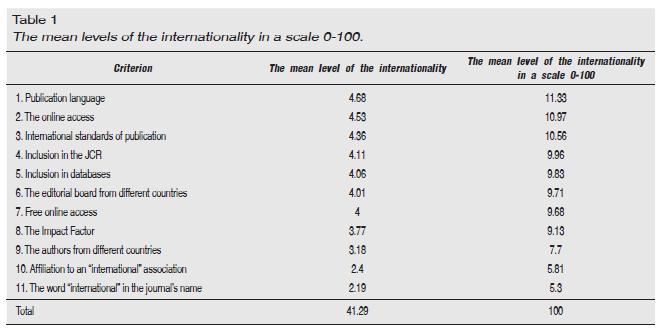
The next step consisted of finding the way of applying each criterion to the scientific publications.
The publication language
Once again the calculation of the publication language is based on the survey conducted by Buela-Casal & Zych (2009). The mean level of the internationality in this criterion is calculated as already described and this would be given to a journal which would publish articles in all the languages which were established as important for the internationality by means of the survey. Thus, this criterion is divided into the 9 languages: English, French, Spanish, Chinese, Italian, German, Russian, Japanese and Portuguese.
As the mean level of the internationality of this criterion in a 0-100 scale is 11.33 the importance of each publication language is calculated multiplying the mean level of the internationality of a language (4.89 – English, 2.23 – French, 2.08 – Spanish, 1.77 – Chinese, 1.72 - Italian, 0.32 –. German, 0.1 – Russian, 0.05 – Japanese and 0.02 – Portuguese, according to the survey) by the mean internationality level of the criterion "publication language" in the 0-100 scale (11.33) and then dividing the result by the sum of all the mean levels of the internationality of all the important languages (13.18 according to the survey).
The calculation of the scores for each language can be seen in the table 2.
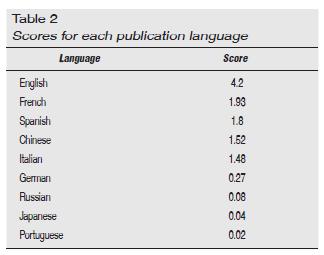
If a journal publishes articles in more than one language the score in this criterion is a sum of the scores in all the languages. For instance, if a journal publishes in English (4.2) and Spanish (1.8) it would obtain 6 in the criterion "publication language".
The online access
The online access can be divided into four subcategories: a journal which has an online access to the full texts of the articles including a current issue would get the maximum points in the criterion "online access"; a journal which has an online access to the full texts of the articles but not to the current issue; a journal which has an online access to the abstracts; A journal which has an access to the index and journals with no online access which would get 0 points in this criterion.
In this case the points of the criterion need to be divided into the four subcriteria. The average for each subcriterion can be seen in the table 3.
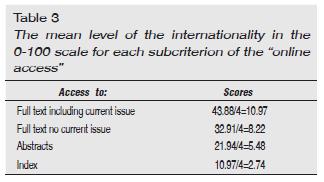
International standards of publication and the Inclusion in the JCR
As the international standards of publication is a criterion of "all or nothing" type, all the points are given to journals which accomplish this criterion (10.56) and zero points to these which do not utilize them. The Inclusion in the JCR is also the "all or nothing type" of criterion. In this case the points of the mean level of the internationality in the 0-100 scale would be given to journals which are included in the Journal Citation Report (9.96) and those which are not included would get no points.
Inclusion in databases
It is very difficult to apply this criterion to scientific publications as the maximum number of databases in which a journal can be included does not exist. One of the possibilities is to assign the maximum score to the one which is included in most databases among the journals which should be classified. If another with a higher number of databases is found it is necessary to reassign the points. This means that the number of the subcriteria in this criterion depends on a journal. Thus, the score of the mean level of the internationality in the 0-100 scale is given for each database (9.83) and than the total score needs to be divided into the number of databases of a journal in which it is the highest to obtain the average.For instance, if a journal with the highest number of databases is included in 10 of them it would get 98.3 points which divided into 10 would be 9.83 and another journal included in 5 databases would get 49.15 which divided into 10 gives 4.91.
The editorial board member's countries
This criterion is very similar to the "inclusion in databases" as also in this case there is no maximum number of countries from which the members of an editorial board are from. Exactly in the same way the points of the mean level of the internationality would be assigned for each country (9.71) and than would be divided into the number of the countries of the editorial board members of a journal in which it is the highest to obtain the average. The journals which editorial board members are from one country get zero points. If necessary the points are reassigned.
Free online access
The criterion can be calculated in a similar way as this of the online access. The criterion is divided into the four subcriteria: free access to full text including current issue; free access to full text no current issue, free access to abstracts, free access to the index, no access – zero points.
This can be seen in the table 4.
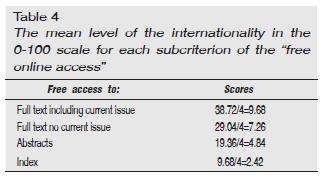
The Impact Factor
The impact factor as the one measured by ISI (Institute for Scientific Information) can be scored dividing the journals into quartiles: the first quartile, the journals from the second quartile, the third quartile and the publications from the forth quartile. In this case, the first quartile is the one with the highest and the forth the one with the lowest Impact Factor.
As the quartiles are the four subcriteria of the criterion it is calculated as shown in the table 5.
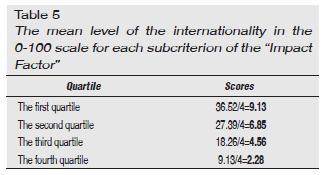
The author's countries
The number of the countries from which the authors who publish in a journal are from should be divided by the total number of the articles as it is more useful to utilize the mean number of countries from which the authors are from per article. In other words, the mean number of the author's origin countries, among the journals which are being classified is calculated dividing the number of the author's origin countries in a year by the number of the articles published in the same year.
The number of the subgroups would depend on the journals which are being analyzed. For example, if it is possible to classify them into the groups in which the mean number of countries are 0.1; 0.2; 0.3 (...) 1; there would be ten subgroups.
Each subgroup would be assigned a number (for example from one to ten if there are ten, where the lowest mean number of countries would get one and the highest would get ten) and it would be multiplied by the mean level of the internationality in the 0-100 scale for this criterion (7.7) which needs to be divided into the total number of subgroups (for example ten).
Journal's affiliation to associations with the word "international" in the name and the inclusion of the word "international" in the journal's name
These two criteria are of the "all or nothing" type and as a result the publications affiliated to associations which include the word "international" in the name would get all the points (5.81) and zero points are assigned to these which do not include it. In case of the inclusion of the word "international" in the journal's name, if it is filled in it would get 5.3.
The Internationality Index
To create the Internationality Index it is necessary to sum up the scores of each journal in all the criteria which give the total scores in the Internationality Index. In the last step the group of journals should be sorted by the final scores.
The Internationality Index of Revista Latinoamericana de Psicología
The scores of RLP in eight criteria of the Internationality Index which do not depend on the group of journals which are being analyzed are shown in table 6.
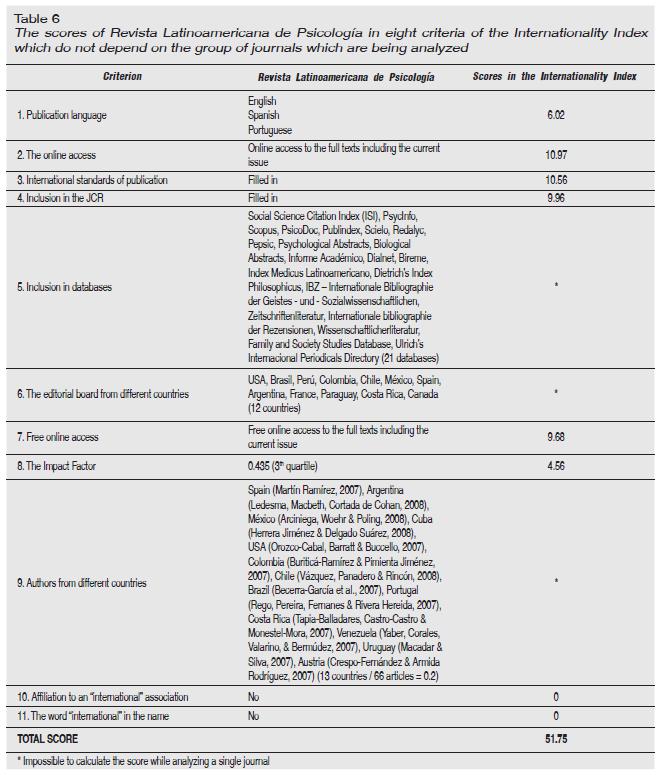
As can be seen in table 6, Revista Latinoamericana de Psicología obtained 51.75 out of 72.74 in eight of the eleven criteria of the Internationality Index.
Inclusion in databases
Revista Latinoamericana de Psicología is included in 21 databases. From the qualitative point of view it can be said that the journal fills in the criterion and can be considered international.
If analyzed together with Spanish journals of psychology, RLP would score 9.83 which is the highest number of databases from the group. If analyzed in the group of Iberoamerican psychology journals included in the Web of Science within 2005 and 2006, it would also get 9.83 (the same score as in 2005 and 2006 when the number of databases was also 21).
The editorial board from different countries
In case of this criterion, RLP would get 8.96 and only two journals from the group of Spanish psychology journals would score higher (International Journal of Clinical and Health Psychology and International Journal of Psychology and Psychological Therapy). Among Iberoamerican psychology journals included in the Web of Science analyzed within 2005 and 2006, it would get 9.71. The number of countries of origin of the editorial board members has increased to 12 (in 2005 and 2006 it was 11).Authors from different countries
In this criterion, the ratio of authors from different countries / the number of articles in case of Revista Latinoamericana de Psicología is 0.2 which would get the score of 3.08. It should be taken into account that, among Spanish psychology journals there would be 2 with scores higher than Revista Latinoamericana de Psicología (Metodología de las Ciencias de Comportamiento and Psicológica). If compared to Iberoamerican psychology journals analyzed in 2005 and 2006, it would score 3.08 which would be lower than within 2005 and 2006 (4.62) but higher than other Iberoamerican psychology journals included in the WOS during these years.
The Internationality Index of RLP
The scores obtained by RLP in the three criteria which depend on the group of journals which are being analyzed can be seen in table 7.

Thus, Revista Latinoamericana de Psicología would get 73.62 out of 100 among the Spanish psychology journals and 74.37 among the Iberoamerican psychology journals included in the Web of Science, analyzed in 2005 and 2006, in all the eleven criteria of the Internationality Index. In both cases it would be the most international journal as the most international Spanish psychology journal (International Journal of Clinical and Health Psychology) got 68.81 and the most international Iberoamerican psychology journal analyzed in 2005 and 2006 (Psicothema) scored 64.94.
The internationality of Revista Latinoamericana de Psicología in the last two years has increased in comparison to the analysis conducted in 2005 and 2006 (Zych & Buela-Casal, 2007). The higher score of the journal is mainly due to the increase in the number of languages of publication (from 1 to 3), free online access including the current issue and increased Impact Factor. The evolution of the latter can be seen in the table 8.
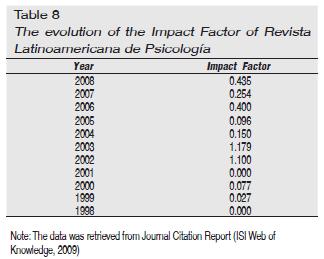
Discussion
As already mentioned in the introduction of the current paper, the first reliable measure of the internationality together with its application to the scientific publications was established by Buela-Casal et al. (2006) and Buela- Casal & Zych (2007). Taking into account that three of the eleven criteria of the Internationality Index depend on the group of the journals which are being analyzed it seemed that it would not be possible to calculate it in case of one and only publication. Although it is true from the strictly quantitative point of view, the current paper shows how to evaluate the internationality of a single journal.
It is important to take into account that nowadays we are living in the era of globalization and free flow of information. For this reason, among others, it is becoming more and more important to increase the internationality of the scientific publication and share it between the countries. Probably for these reasons the internationality has become so important, although its meaning had not been established. Also for these reasons the best way of calculating the Internationality Index is by comparing a journal to a group of reference, as it is possible to know which journal is "the most international" only if it is compared to other scientific publications. This reflects that the concept is dynamic and nowadays the internationality is changing. It has become even more important taking into account that we live in times of globalization, internacionalization pretending to create the society of knowledge (Ardila, 2007). Thus, nowadays it is necessary to increase the internationality of psychology (Cole, 2006).
Although it is crucial to compare a journal to its group of reference to examine its level of the internationality, it is also important to be able to evaluate a single journal. As showed in the current study, it can be done calculating the scores in the criteria which do not depend on the group of reference and then examining whether the rest of the criteria are filled in, comparing at the same time to the groups of journals which Internationality Index has already been calculated.
Taking into account the results of the paper, Revista Latinoamericana de Psicología is indeed very international journal. Moreover, it is the most international journal of all the publications which have ever been analyzed.
References
Adair, J. G. (2002). La psicología internacional. In R. Ardila (Ed.), La psicología en el futuro (pp. 49-56). Madrid: Pirámide. [ Links ]
Adair, J. K. & Vohra, N. (2003). The explosion of knowledge, referente, and citations: Psychology's unique response to a crisis. American Psychologist, 58, 15-23. [ Links ]
Alegre, O. M. & Villar, L. M. (2007). Evaluación de la formación en línea del profesorado de cinco universidades españolas. Revista de Universidad y Sociedad del Conocimiento (RUSC), 4, 1-13. [ Links ]
Arciniega, L. M., Woehr, D. J. & Poling, T. L. (2008). El impacto de la diversidad de valores en los equipos sobre las variables de proceso y el desempeño de la tarea. Revista Latinoamericana de Psicología, 40, 523-538. [ Links ]
Ardila, R. (1982). International psychology. American Psychologist, 37, 323-329. [ Links ]
Ardila, R. (Ed.) (2002). La psicología en el futuro, Madrid: Pirámide. [ Links ]
Ardila, R. (2007). The nature of psychology: The great dilemmas. American Psychologist, 62, 906-912. [ Links ]
Becerra-García, A. M., Madalena, A. C., Estanislau, C., Rodríguez-Rico, J. L., Dias, H., Bassi, A., Chagas-Bloes, D. A. & Morato, S. (2007). Ansiedad y miedo, su valor adaptativo y maladaptaciones. Revista Latinoamericana de Psicología, 39, 75-81. [ Links ]
Buela-Casal, G. (2001). La psicología española y su proyección internacional, el problema del criterio: internacional, calidad y castellano y/o inglés. Papeles del psicólogo, 79, 53-57. [ Links ]
Buela-Casal, G. (2003). Evaluating quality of articles and scientific journals. Proposal of weighted impact factor and a quality index? Psicothema, 15, 23-35. [ Links ]
Buela-Casal, G. (2005a). El Sistema de Habilitación Nacional: criterios y proceso de evaluación. Análisis y Modificación de Conducta, 31, 313-341. [ Links ]
Buela-Casal, G. (2005b). Situación actual de la productividad científica de las universidades españolas. International Journal of Clinical and Health Psychology, 5, 175-190. [ Links ]
Buela-Casal, G. (2007a). Consideraciones metodológicas sobre el procedimiento de acreditación y del concurso de acceso a cuerpos de funcionarios docentes universitarios. Revista Electrónica de Metodología Aplicada, 12, 1-14. [ Links ]
Buela-Casal, G. (2007b). Reflexiones sobre el sistema de acreditación del profesorado funcionario de Universidad en España. Psicothema, 19, 473-482. [ Links ]
Buela-Casal, G., Bermúdez, M. P., Sierra, J. C., Quevedo, R. & Castro, A. (2009). Ranking de productividad en investigación de las universidades públicas españolas. Psicothema, 21, 309-317. [ Links ]
Buela-Casal, G. & Castro, A. (2008a). Análisis de la evolución de los programas de doctorado con Mención de Calidad en las universidades españolas y pautas para su mejora. Revista de Investigación en Educación, 5, 49-60. [ Links ]
Buela-Casal, G. & Castro, A. (2008b). Criterios y estándares para la obtención de la Mención de Calidad en programas de doctorado: evolución a través de las convocatorias. International Journal of Psychology and Psychological Therapy, 8, 127-136. [ Links ]
Buela-Casal, G., Gutiérrez, O., Bermúdez, M. P. & Vadillo, O. (2007). Comparative study of international academic rankings of universities. Scientometrics, 71, 349-365. [ Links ]
Buela-Casal, G., Perakakis, P., Taylor, M. & Checa, P. (2006). Measuring Internationality: Reflections and perspectives on academic journals. Scientometrics, 67, 45-65. [ Links ]
Buela-Casal, G. & Sierra, J. C. (2007). Criterios, indicadores y estándares para la acreditación de profesores titulares y catedráticos de universidad. Psicothema, 19, 537-551. [ Links ]
Buela-Casal, G. & Zych, I. (2009). The first reliable measure of the internationality of the scientific publications. In press. [ Links ]
Buela-Casal, G., Zych, I., Sierra, J. C. & Bermúdez, M. P. (2007). The Internationality Index of the Spanish Psychology Journals. International Journal of Clinical and Health Psychology, 7, 899-910. [ Links ]
Buriticá-Ramírez, E. & Pimienta-Jiménez, H. J. (2007). Corteza frontopolar humana: Área 10. Revista Latinoamericana de Psicología, 39,127-142. [ Links ]
Castro, A. y Buela-Casal, G. (2008). La movilidad de profesores y estudiantes en programas de postgrado: ranking de las universidades españolas. Revista de Investigación en Educación, 5, 61-74. [ Links ]
Christensen, F. H., Ingwersen, P. & Wormell, I. (1997). Online determination of the journal impact factor and its international properties, Scientometrics, 40, 529-540. [ Links ]
Cole, M. (2006). Internationalism in psychology: We need it now more than ever. American Psychologist, 61, 904-920. [ Links ]
Crespo-Fernández, J. A. & Rodríguez, C. (2007). Bases neuroanatómicas, neurobiológicas y del aprendizaje de la conducta de adicción a cocaína. Revista Latinoamericana de Psicología, 39, 83-107. [ Links ]
David, H. P. & Buchanan, J. (2002). International psychology. En I. B. Weiner (Ed. of the serie) and D. K. Freedheim (Ed. of the volumen), Handbook of Psychology: Vol. 1. History of Psychology (pp. 509-534). New Jersey: John Wiley and Sons. [ Links ]
Del Río, L. (2008). Cómo implantar y certificar un sistema de gestión de la calidad en la Universidad. Revista de Investigación en Educación, 5, 5-11. [ Links ]
Dumont, K. & Louw, J. (2009). A citation analysis of Henri Tajfel's work on intergroup relations. International Journal of Psychology, 44, 46-59. [ Links ]
Glanzel, W., Schubert, A. & Czerwon, H. J. (1999). A bibliometric analysis of international scientific cooperation of the European Union (1985-1995). Scientometrics, 45, 185-202. [ Links ]
Greeson, L. E. (1991). Cultural Ethnocentrism and Imperialism in Citations of American and Scandinavian Psychological Research. International Journal of Psychology, 26, 262-268. [ Links ]
Herrera, L. F. & Delgado Suárez, J. (2008). Un acercamiento a la definición de la controlabilidad en el proceso de salud-enfermedad. Revista Latinoamericana de Psicología, 40, 475-484. [ Links ]
ISI Web of Knowledge. (2009). Journal Citation Reports. Retrieved on June 22, 2009, from http://www.accesowok.fecyt.es/jcr/. [ Links ]
Jing, Q. (2000). Internatioanl psychology. In K. Pawlik & M. Rosenzweig (Eds.), The international handbook of psychology (pp. 570-584). London: Sage. [ Links ]
Ledesma, R., Macbeth, G. & Cortada de Kohan, N. (2008). Tamaño del efecto: revisión teórica y aplicaciones con el sistema estadístico VISA. Revista Latinoamericana de Psicología, 40, 425-439. [ Links ]
Luukkonen, T., Tijssen, R. J. W., Person, O. & Sirvertsen, G. (1993). The Measurement of International Scientific Collaboration. Scientometrics, 28, 15-36. [ Links ]
Macadar, O. & Silva, A. (2007). Comunicación eléctrica en peces sudamericanos del origen gymnotiformes. Revista Latinoamericana de Psicología, 39, 31-45. [ Links ]
Martín, J. (2007). Televisión y violencia. Revista Latinoamericana de Psicología, 39, 327-349. [ Links ]
Melin, G. (1999). Impact of national size on research collaboration - A comparison between Northern European and American universities. Scientometrics, 46, 161-170. [ Links ]
Melin, G. & Persson, O. (1996). Studying research collaboration using coauthorships. Scientometrics, 36, 363-77. [ Links ]
Montero, I. & León, O. G. (2007). A guide for naming research studies in Psychology. International Journal of Clinical and Health Psychology, 7, 847-862. [ Links ]
Muñiz, J. & Fonseca-Pedrero, E. (2008). Construcción de instrumentos de medida para la evaluación universitaria. Revista de Investigación en Educación, 5, 13-25. [ Links ]
Musi-Lechuga, B., Olivas-Ávila, J. & Buela-Casal, G. (2009). Producción científica de los programas de doctorado en Psicología Clínica y de la Salud de España. International Journal of Clinical and Health Psychology, 9, 161-173. [ Links ]
Musi-Lechuga, B., Olivas-Ávila, J., Portillo-Reyes, V. & Villalobos-Galvis, F. (2005). Producción de los profesores funcionarios de psicología en España en artículos de revistas con factor de impacto de la Web of Science. Psicothema, 17, 539-548 [ Links ]
Narvaezberthelmot, N. (1995). An Index to Measure the International Collaboration of Developing-Countries Based on the Participation of National Institutions - the Case of Latin-America. Scientometrics, 34, 37-44. [ Links ]
Orozco-Cabal, L. F., Barratt, E. S. & Buccello, R. R. (2007). Implicaciones para el estudio de la neurobiología de la experiencia consciente. El acto impulsivo. Revista Latinoamericana de Psicología, 39, 109-126. [ Links ]
Pagani, R., Vadillo, O., Buela-Casal, G., Sierra, J. C., Bermúdez, M. P., Gutiérrez-Martínez, O., Agudelo, D., Bretón, J. & Teva, I. (2006). Estudio internacional sobre criterios e indicadores de calidad de las universidades. Madrid: ACAP. [ Links ]
Pawlik, K. & Rosenzweig, M. (2000). The international handbook of psychology. London: Sage. [ Links ]
Ramos-Álvarez, M., Moreno-Fernández, M. M., Valdés-Conroy, B. & Catena, A. (2008). Criteria of the peer review process for publication of experimental and quasi-experimental research in Psychology: A guide for creating research papers. International Journal of Clinical and Health Psychology, 8, 751-764. [ Links ]
Rego, A., Pereira, H., Fernandes, C. & Rivera, M. E. (2007). Comportamientos de ciudadanía docente, motivación y desempeño académico. Revista Latinoamericana de Psicología, 39,253-268. [ Links ]
Rey-Rocha, J. & Martín-Sempere, M.J. (2004). Patterns of the foreign contributions in some domestic vs. international journals on Earth Sciences. Scientometrics, 59, 95-115. [ Links ]
Rodríguez, M. A. (2007). El regional y el global: articulación de la diversidad de funciones de la enseñanza superior. Revista de Universidad y Sociedad del Conocimiento (RUSC), 4, 2, 5-15. [ Links ]
Ruiz-Pérez, R., Delgado, E. & Jiménez-Contreras, E. (2006). Criterios del Institute for Scientific Information para la selección de revistas científicas. Su aplicación a las revistas españolas: metodología e indicadores. International Journal of Clinical and Health Psychology, 6, 401-424. [ Links ]
Sierra, J. C., Buela-Casal, G., Bermúdez, M. P. & Santos, P. (2009). Diferencias por sexo en los criterios y estándares de productividad científica y docente en profesores funcionarios en España. Psicothema, 21, 124-132. [ Links ]
Sierra, J. C., Buela-Casal, G., Bermúdez, M. P. & Santos-Iglesias, P. (2008). Análisis transnacional del sistema de evaluación y selección del profesorado universitario. Interciencia, 33, 251-257. [ Links ]
Smith, P. B. (2005). Is there an indigenous European social psychology? International Journal of Psychology, 40, 254-262. [ Links ]
Soto, J. (2007). Políticas educativas y nuevos contextos de intervención en relación a las TIC. Panorama actual en el ámbito europeo y español. Revista de Investigación en Educación, 4, 4-21. [ Links ]
Tapia-Balladares, N., Castro-Castro, R. & Monestel-Mora, N. (2007). El desarrollo sociomoral de adolescentes de Costa Rica según el modelo de Gebbs. Revista Latinoamericana de Psicología, 39, 449-471. [ Links ]
Uzun, A. (2004). Assessing internationality of scholarly journals through foreign authorship patterns: the case of major journals in information science, and scientometrics. Scientometrics, 61, 457-465. [ Links ]
Vázquez, J. J., Panadero, S. & Rincón, P. P. (2008). Implicación de las actitudes y desesperanza en la participación electoral de estudiantes españoles y latinoamericanos. Revista Latinoamericana de Psicología, 40, 551-564. [ Links ]
Villalobos-Galvis, F. & Puertas-Campanario, R. (2007). Impacto e internacionalidad de tres revistas iberoamericanas en revistas de psicología de España. Revista Latinoamericana de Psicología, 39, 593-608. [ Links ]
Yaber, G., Corales, E., Valarino, E. & Bermúdez, J. (2007). Estrés ocupacional de despachadores de carga eléctrica. Revista Latinoamericana de Psicología, 39, 297-309. [ Links ]
Zitt, M. & Bessecoulard, M. (1998). Internationalization of Scientific Journals: a Measurement Based on Publication and Citation Scope. Scientometrics, 41, 255-271. [ Links ]
Zitt, M. & Bessecoulard, M. (1999). Internationalization of Communication - a View on the Evolution of Scientific Journals. Scientometrics, 46, 669-685. [ Links ]
Zych, I. & Buela-Casal, G. (2007). Análisis comparativo de los valores en el Índice de Internacionalidad de las revistas iberoamericanas de psicología incluidas en la Web of Science. Revista Mexicana de Psicología, 24, 7-14. [ Links ]














